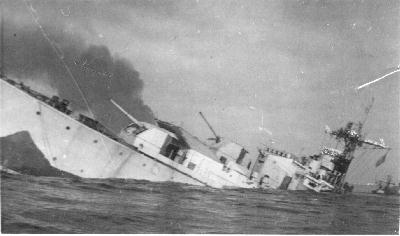 |
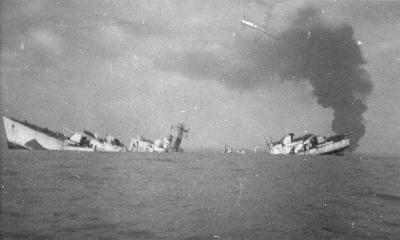 |
A short time after D-Day, HMS Swift was scheduled to participate in Operation Decoy. The operation called for Swift to drop her anchor about a half mile off the coast of France still occupied by the enemy. Here the ship would act as a decoy in order to have the German gun positions open fire. Once spotted, the battleship HMS Rodney, which was about five miles away, would open up with a broadside and destroy the German guns. Prior to the the operation, Swift's radar antenna was shot off by an enemy plane. She was still seaworthy but there would be no warning should enemy aircraft approach.Now, fate would change everything. Due to Swift's unserviceable radar antenna, Captain 'D' (the name given to the flotilla leader) ordered Algonquin to take Swift's place in Operation Decoy as he was in charge of the Flotilla. That evening, Algonquin was out on patrol against E-boats. During the night a Ju88 attacks Algonquin and drops two 500 pound bombs. Luckily, both were near misses and only rocked the ship. Unknown to anyone, an E-boat planted a mine near Algonquin's buoy during the night. When Swift arrived at 0700, she unfortunately hit the mine and got what was intended for Algonquin. Swift had her keel broken in two and took nearly 6 hours to sink. Another ship on the far side of Swift picked up the survivors but an estimated 44 seamen lost their lives in that action.
Operation Decoy continued as planned and lady luck smiled on Algonquin. During the late morning and early afternoon, enemy guns opened up on Algonquin and all were near misses. The bearing of the shore guns was given to HMS Rodney. The British battleship opened fire and you could see the 500 pound shells flying across the sky as they zeroed in on their intended targets. Spotting the projectiles was very easy because the glistening sun made them very visible. Believe it or not, but in amongst the danger, there was a small consolation prize. When the German shells were dropping around Algonquin, they were killing multitudes of fish. Seizing an opportunity, the stunned fish were gathered in abundance and enough were had to feed the entire crew.
Algonquin firing her guns during night action on D-Day.
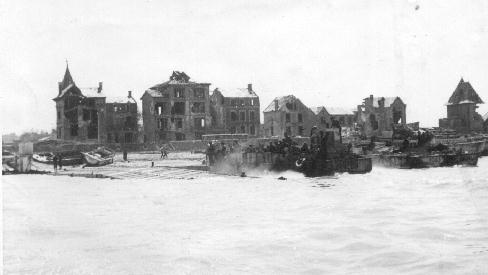 |
On D-Day, Algonquin was able to get this close to shore without going aground. The first wave of Canadian troops are well ashore by this time.
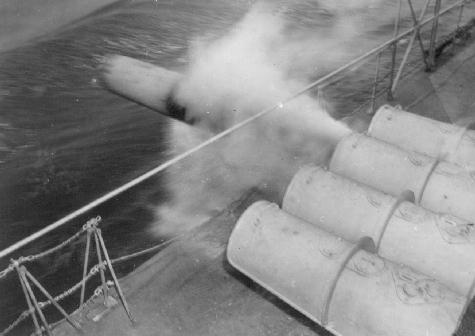 |
During action, Algonquin launches a torpedo. Hot gas, produced by a small explosive charge pushes the torpedo out the tube employing the same principle as blowing a spitball through a straw. The torpedo only had to clear the deck when its propulsion system kicked in and the torpedo made a track to the target.
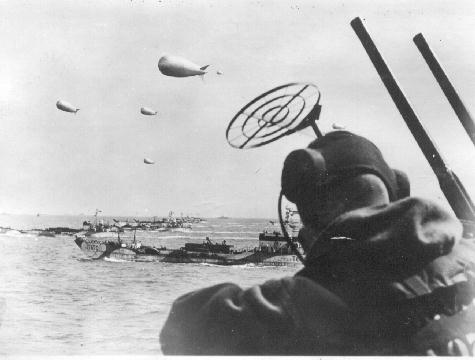 |
Landing barges loaded with Canadian and British troops head for France on D-Day. A lone anti-aircraft gunner stands vigil and on the alert for enemy aircraft.
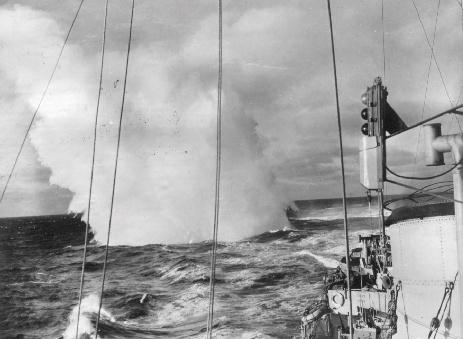 |
Depth charging produced dramatic explosions as evidenced in this photo of Algonquin attacking a target. During one attack, scores and scores of depth charges were dropped but without any luck. Another destroyer joined Algonquin in the attack. Shortly thereafter, a report was received that an oil tanker was sunk in the same area. It never quite sank but continued to float about 150 feet down. It was then realized that the tanker may have been the target detected by ASDIC.On another occasion, Algonquin was in company with six other destroyers carrying out an attack on a submarine. She accidentally crossed over where another destroyer had dropped a charge. The explosive detonated about 50 feet below Algonquin's keel. To the crew, it felt like the ship was torpedoed. Everyone was up on deck in seconds. Once everyone realized what happened, all hands went down to the mess deck to laugh about the incident.
|
|